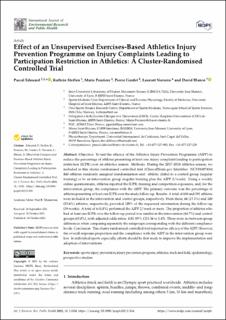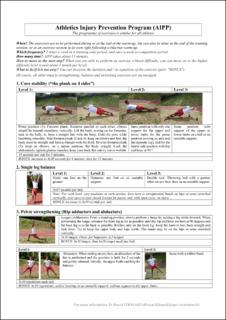| dc.contributor.author | Edouard, Pascal | |
| dc.contributor.author | Steffen, Kathrin | |
| dc.contributor.author | Peuriere, Marie | |
| dc.contributor.author | Gardet, Pierre | |
| dc.contributor.author | Navarro, Laurent | |
| dc.contributor.author | Blanco, David | |
| dc.date.accessioned | 2022-03-21T18:23:13Z | |
| dc.date.available | 2022-03-21T18:23:13Z | |
| dc.date.created | 2021-11-03T17:47:21Z | |
| dc.date.issued | 2021 | |
| dc.identifier.citation | International Journal of Environmental Research and Public Health. 2021, 18(21), Artikkel 11334. | en_US |
| dc.identifier.issn | 1661-7827 | |
| dc.identifier.uri | https://hdl.handle.net/11250/2986632 | |
| dc.description | This article is an open access article distributed under the terms and conditions of the Creative Commons Attribution (CC BY) license (https://creativecommons.org/licenses/by/4.0/). | en_US |
| dc.description.abstract | Objective: To test the efficacy of the Athletics Injury Prevention Programme (AIPP) to reduce the percentage of athletes presenting at least one injury complaint leading to participation restriction (ICPR) over an athletics season.
Methods: During the 2017–2018 athletics season, we included in this cluster randomised controlled trial (ClinicalTrials.gov Identifier: NCT03307434) 840 athletes randomly assigned (randomisation unit: athletic clubs) to a control group (regular training) or to an intervention group (regular training plus the AIPP 2/week). Using a weekly online questionnaire, athletes reported the ICPR, training and competition exposures, and, for the intervention group, the compliance with the AIPP. The primary outcome was the percentage of athletes presenting at least one ICPR over the study follow-up. Results: A total of 449 and 391 athletes were included in the intervention and control groups, respectively. From them, 68 (15.1%) and 100 (25.6%) athletes, respectively, provided 100% of the requested information during the follow-up (39 weeks). A total of 6 (8.8%) performed the AIPP 2/week or more. The proportion of athletes who had at least one ICPR over the follow-up period was similar in the intervention (64.7%) and control groups (65.0%), with adjusted odds ratios: 0.81 (95% CI 0.36 to 1.85). There were no between-group differences when comparing separately the subgroups corresponding with the different compliance levels.
Conclusion: This cluster randomised controlled trial reported no efficacy of the AIPP. However, the overall response proportion and the compliance with the AIPP in the intervention group were low. In individual sports especially, efforts should be first made to improve the implementation and adoption of interventions. | en_US |
| dc.language.iso | eng | en_US |
| dc.subject | athletics | en_US |
| dc.subject | epidemiology | en_US |
| dc.subject | injury prevention program | en_US |
| dc.subject | prospective studies | en_US |
| dc.subject | sports injury prevention | en_US |
| dc.subject | track and field | en_US |
| dc.title | Effect of an unsupervised exercises-based athletics injury prevention programme on injury complaints leading to participation restriction in athletics: A cluster-randomised controlled trial | en_US |
| dc.type | Peer reviewed | en_US |
| dc.type | Journal article | en_US |
| dc.description.version | publishedVersion | en_US |
| dc.rights.holder | © 2021 by the authors | en_US |
| dc.source.pagenumber | 15 | en_US |
| dc.source.volume | 18 | en_US |
| dc.source.journal | International Journal of Environmental Research and Public Health | en_US |
| dc.source.issue | 21 | en_US |
| dc.identifier.doi | 10.3390/ijerph182111334 | |
| dc.identifier.cristin | 1951152 | |
| dc.description.localcode | Institutt for idrettsmedisinske fag / Department of Sports Medicine | en_US |
| dc.source.articlenumber | 11334 | en_US |
| cristin.ispublished | true | |
| cristin.fulltext | original | |
| cristin.qualitycode | 1 | |

